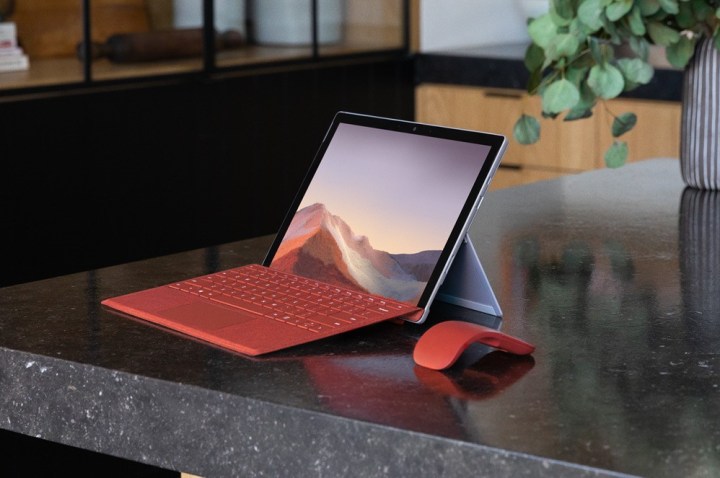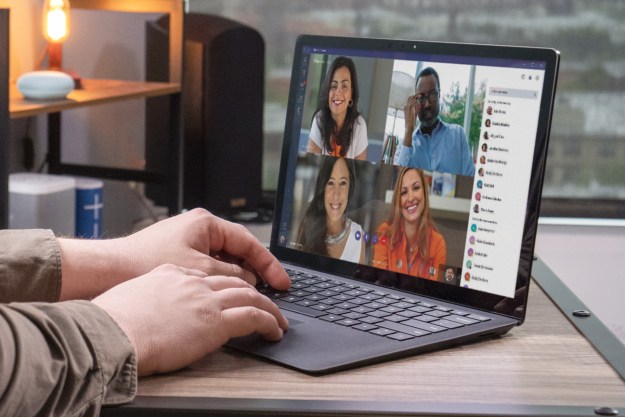Alongside headline-stealing new devices like the dual-screen Surface Duo smartphone and the folding, tablet-like Surface Neo, Microsoft upgraded its bread-and-butter hardware lineup in October 2019 with the Surface Pro 7. The latest generation of this now-iconic Windows 10 tablet looked like a solid upgrade.
However, it wasn’t the only Surface Pro Microsoft announced last year. Enter the Surface Pro X, an ARM-based 2-in-1 that uses a CPU stemming from Microsoft’s partnership with Qualcomm. It’s supposedly three times more powerful per watt than the older Surface Pro 6. That’s some exciting stuff, certainly, but is it enough to steal buyers from the Surface Pro 7?
Design

Both of these 2-in-1s look like Surface Pros. That’s a good thing because Microsoft maintains a unique look and feel with the Surface Pro line while still keeping it modern.
The Surface Pro 7 is essentially unchanged on the outside, with the same 12.3-inch PixelSense display, 3:2 aspect ratio, and 2,736 x 1,824 resolution for a sharp 267 pixels per inch (PPI). Meanwhile, the Surface Pro X has a slightly larger PixelSense display at 13 inches. It packs a 2,880 x 1,920 resolution and 3:2 aspect ratio, totaling 267 PPI. You are correct in noticing that they have the same pixel density.
Despite the larger screen, the Surface Pro X is slightly thinner at a wafer-like 7.3mm (0.28in) compared to Pro 7 at 8.5mm (0.33in). Both 2-in-1s are roughly equally light, at 1.7 pounds (there’s a 1-gram difference). Given the thinness of the Surface Pro X, we suspect that it feels like a smaller device.
The Surface Pro X offers a few design tricks that make it a more attractive device than the Surface Pro 7. First, the Surface Pro X has an access cover under the kickstand, which can allow for the solid-state drive (SSD) to get swapped out for a new one. Microsoft cautions, however, that the hard drive “is not user removable” and that it’s still “only removable by [a] skilled technician following Microsoft provided instructions.” In any case, it appears to be possible to upgrade the SSD in a Pro X, and that’s still a first for the Surface line, and perhaps a first for tablets, period.
Also, while the Surface Pro 7 uses the same Type Cover and Pens as past models, the Surface Pro X has a new Type Cover with a slot that a new Slim Pen fits into for wireless charging.
Microsoft enhanced connectivity in the Surface Pro 7, adding a USB-C port (no Thunderbolt 3) to go with a USB-A port, a 3.5mm headphone jack, a MicroSDXC card slot, and the same Surface Connect port as on previous Surface Pro models. In comparison, the Surface Pro X has two USB-C ports to go with its Surface Connect port, Surface keyboard connector port, and NanoSIM slot for LTE wireless connectivity. However, it lacks the USB-A port offered on the Pro 7 model.
Finally, both models can be bought in Matte Black while the Surface Pro 7 is the only model offered in Platinum.
All in all, the Surface Pro X is slimmer and enjoys a slightly larger display, with some nice design touches thrown in for good measure.
Performance

Here’s where these 2-in-1s are most different.
The Surface Pro 7 uses Intel’s 10th-gen “Ice Lake” CPUs with options for the Core i3-1005G1, i5-1035G4, and i7-1065G7 processors. It also has up to 16GB of RAM and up to a 1TB SSD. That gives the Surface Pro 7 laptop-like performance.
The Surface Pro X, on the other hand, uses a custom Microsoft SQ1 ARM-based processor based on Qualcomm’s Snapdragon 8cx chip. It runs at up to 7 watts of power — significantly higher than similar chips that typically run at 2 watts. The SQ1 has both a CPU and GPU integrated on the same chip and offers up to 2 teraflops of graphics performance and 9 teraflops of total performance. This chip also includes an integrated A.I. engine.
Outside the custom processor, the Pro X provides up to 16GB of
Comparing the Intel chips against Microsoft’s custom processor is moot at this point. The major differences between the two stem from the underlying processor design. Intel’s x86-based chips typically target high performance first and battery second, though Intel attempts to narrow that gap with each new generation. ARM-based Snapdragon chips mostly trade performance for better battery life. The recent collaboration between Qualcomm and Microsoft is attempting to change that, but you’ll still run across compatibility issues.
Most developers release 32-bit and 64-bit versions of their apps. A Windows 10 PC with an ARM-based chip can run the 32-bit versions, but they can only run 64-bit apps if they’re ported to ARM64. In other words, many apps you run on an Intel-based PC — including the Pro 7 — can’t do so correctly on an ARM-based PC like the Pro X. You’re not quite so limited like the original Surface and Windows RT, but there are limitations nonetheless.
In our review of the Surface Pro 7, we saw a 20% improvement in multi-core performance over the previous generation. More specifically, Handbrake converted a 4K video 24% faster than the Pro 6 model we previously tested. If you’re thinking about gaming on this 2-in-1 PC, stick with the Core i7 configuration and its G7-level Iris Plus graphics. Unfortunately, the SSD was slower than expected, moving at half the speed of the SSDs installed in the Dell XPS 13 2-in-1.
Ultimately, the only way to compare the Surface Pro 7 and Pro X is to use benchmark tools that are friendly to both x86 (Intel) and ARM (Snapdragon) chips. Geekbench 5 is one of those tools, which saw the Surface Pro 7 Core i5 configuration outperform the Surface Pro X in multi-core testing: 4412 vs 2813, respectively. In single-core testing, the Pro 7’s Core i5 scored a higher 1218 than the Pro X’s lower score of 735.
In other benchmarks like BrowserBench Speedometer and JetStream 2, the Surface Pro 7 pulled way ahead of the Surface Pro X.
Portability
Both of these laptops are thin and light and will barely register in a backpack. The Surface Pro X is much thinner, but weight is roughly equal. These are two of the most portable 2-in-1 PCs around.
Battery life

Microsoft dropped its estimate for the Surface Pro 7 from the 13.5 hours promised with the Surface Pro 6 to just 10.5 hours of mixed use, in reference to the fast CPUs inside.
Compared to the Surface Pro 6 we previously reviewed, the newer Pro 7 model died an hour and twenty minutes earlier than its predecessor in light web browsing. While specifications list up to 10.5 hours of mixed use, we found that ceiling to be lower at 8.5 hours.
Meanwhile, Microsoft boasts up to 13 hours of normal use on the Surface Pro X, but the real-world numbers appear to be around nine hours. That’s slightly more than the Pro 7, but not a significant increase given the battery-efficient chip inside. Why? Because Microsoft and Qualcomm tweaked this custom chip for more performance than the typical Snapdragon chip for phones and tablets.
Which is better?

If you want performance and compatibility, get the Surface Pro 7. If you want a highly portable device and are mostly concerned about streaming Netflix, get the Surface Pro X.
But let’s take a deeper dive into our conclusion.
The Surface Pro 7 starts at $749 for just the tablet and goes up from there. High-end configurations will likely be well over $2,000, and you’ll want to factor in a few hundred dollars for a Type Cover and Surface Pen.
The Surface Pro X starts at$999 for just the tablet and goes up from there. Again, you’ll want to factor in a few hundred dollars for a Type Cover and Slim Pen.
Both of these
We suspect that most users will go with the Surface Pro 7 for performance. But the Surface Pro X certainly offers an interesting alternative with a slightly better battery life.
Editors' Recommendations
- Dell XPS vs. Dell Latitude: here’s how to decide
- Best Surface Laptop and Surface Pro deals: From $450
- Gemini Advanced vs. Copilot Pro: which is the better deal?
- Apple’s Vision Pro to get bespoke Microsoft 365 apps at launch
- Surface Pro 10: all the major changes rumored for the new model


